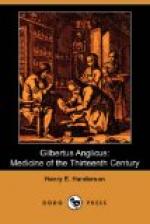EXPLANATORY FOREWORD
In the summer of 1916 the librarian of the Cleveland Medical Library received a manuscript from Dr. Henry E. Handerson with the request that it be filed for reference in the archives of the library. The librarian at once recognized the value of the paper and referred it to the editorial board of the Cleveland Medical Journal, who sought the privilege of publishing it. Dr. Handerson’s consent was secured and the article was set in type. However, when the time came for its publication the author was reluctant to have it appear since he was unable then to read the proof, and because he felt that the material present might not be suitable for publication in a clinical journal. To those who knew him, this painstaking attention to detail and desire for accuracy presents itself as a familiar characteristic. Though actual publication was postponed, the type forms were held, and when the Cleveland Medical Journal suspended publication, its editorial board informed the Council of the Cleveland Medical Library Association of the valuable material which it had been unable to give to the medical world. In the meantime Dr. Handerson’s death had occurred, but the Council obtained the generous consent of the author’s family to make this posthumous publication. It is hoped that those who read will bear this fact in mind and will be lenient in the consideration of typographical errors, of which the author was so fearful.
The Cleveland Medical Library Association feels that it is fortunate in being enabled to present to its members and to others of the profession this work of Dr. Handerson’s and to create from his own labors a memorial to him who was once its president.
Samuel W. Kelley.
Clyde L. Cummer.
Committee on Publication.
BIOGRAPHY
HENRY EBENEZER HANDERSON
Owing to Dr. Handerson’s modesty, even we who were for years associated with him in medical college, in organization, and professional work, knew but little of him. He would much rather discuss some fact or theory of medical science or some ancient worthy of the profession than his own life. Seeing this tall venerable gentleman, sedate in manner and philosophical in mind, presiding over the Cuyahoga County Medical Society or the Cleveland Medical Library Association, few of the members ever pictured him as a fiery, youthful Confederate officer, leading a charge at a run up-hill over fallen logs and brush, sounding the “Rebel yell,” leaping a hedge and alighting in a ten-foot ditch among Federal troopers who surrendered to him and his comrades. Yet this is history. We could perhaps more easily have recognized him even though in a military prison-pen, on finding him dispelling the tedium by teaching his fellow prisoners Latin and Greek, or perusing a precious volume of Herodotus.




